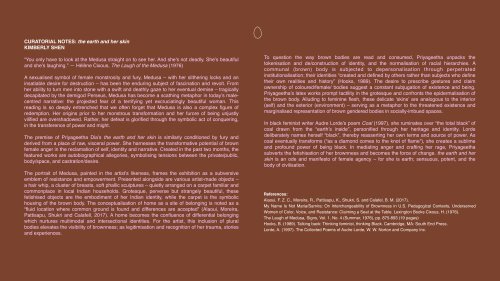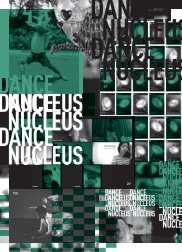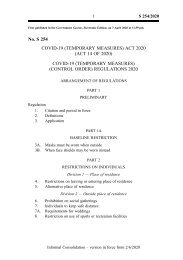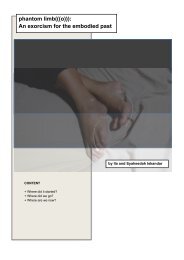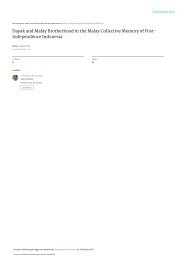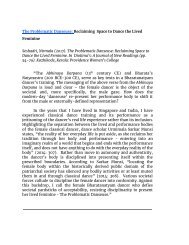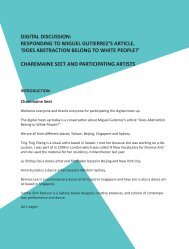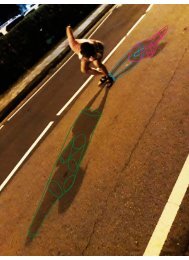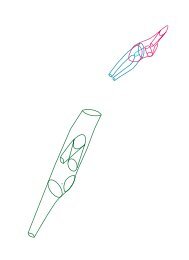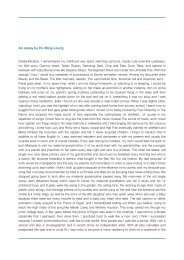In reference to past works
You also want an ePaper? Increase the reach of your titles
YUMPU automatically turns print PDFs into web optimized ePapers that Google loves.
"<br />
CURATORIAL NOTES: the earth and her skin<br />
KIMBERLY SHEN<br />
“You only have <strong>to</strong> look at the Medusa straight on <strong>to</strong> see her. And she’s not deadly. She’s beautiful<br />
and she’s laughing.” ― Hélène Cixous, The Laugh of the Medusa (1976)<br />
A sexualised symbol of female monstrosity and fury, Medusa – with her slithering locks and an<br />
insatiable desire for destruction – has been the enduring subject of fascination and revolt. From<br />
her ability <strong>to</strong> turn men in<strong>to</strong> s<strong>to</strong>ne with a swift and deathly gaze <strong>to</strong> her eventual demise – tragically<br />
decapitated by the demigod Perseus, Medusa has become a scathing metaphor in <strong>to</strong>day’s malecentred<br />
narrative: the projected fear of a terrifying yet excruciatingly beautiful woman. This<br />
reading is so deeply entrenched that we often forget that Medusa is also a complex figure of<br />
redemption. Her origins prior <strong>to</strong> her monstrous transformation and her furore of being unjustly<br />
vilified are overshadowed. Rather, her defeat is glorified through the symbolic act of conquering,<br />
in the transference of power and might.<br />
The premise of Priyageetha Dia’s the earth and her skin is similarly conditioned by fury and<br />
derived from a place of raw, visceral power. She harnesses the transformative potential of brown<br />
female anger in the reclamation of self, identity and narrative. Created in the <strong>past</strong> two months, the<br />
featured <strong>works</strong> are au<strong>to</strong>biographical allegories, symbolising tensions between the private/public,<br />
body/space, and castration/desire.<br />
The portrait of Medusa, painted in the artist’s likeness, frames the exhibition as a subversive<br />
emblem of resistance and empowerment. Presented alongside are various artist-made objects –<br />
a hair whip, a cluster of breasts, soft phallic sculptures – quietly arranged on a carpet familiar and<br />
commonplace in local <strong>In</strong>dian households. Grotesque, perverse but strangely beautiful, these<br />
fetishised objects are the embodiment of her <strong>In</strong>dian identity, while the carpet is the symbolic<br />
housing of the brown body. The conceptualisation of home as a site of belonging is noted as a<br />
“fluid location where common ground is found and differences are accepted” (Alaoui, Moreira,<br />
Pattisapu, Shukri and Calafell, 2017). A home becomes the confluence of differential belonging<br />
which nurtures multimodal and intersectional identities. For the artist, this inclusion of plural<br />
bodies elevates the visibility of brownness; as legitimisation and recognition of her trauma, s<strong>to</strong>ries<br />
and experiences.<br />
To question the way brown bodies are read and consumed, Priyageetha unpacks the<br />
<strong>to</strong>kenisation and de/construction of identity, and the normalisation of racial hierarchies. A<br />
communal (brown) body is subjected <strong>to</strong> depersonalisation through perpetrated<br />
institutionalisation; their identities “created and defined by others rather than subjects who define<br />
their own realities and his<strong>to</strong>ry” (Hooks, 1989). The desire <strong>to</strong> prescribe gestures and claim<br />
ownership of coloured/female/ bodies suggest a constant subjugation of existence and being.<br />
Priyageetha’s latex <strong>works</strong> prompt tactility in the grotesque and confronts the epidermalisation of<br />
the brown body. Alluding <strong>to</strong> feminine flesh, these delicate ‘skins’ are analogous <strong>to</strong> the interior<br />
(self) and the exterior (environment) – serving as a metaphor <strong>to</strong> the threatened existence and<br />
marginalised representation of brown gendered bodies in socially-imbued spaces.<br />
<strong>In</strong> black feminist writer Audre Lorde’s poem Coal (1997), she ruminates over “the <strong>to</strong>tal black” of<br />
coal drawn from the “earth’s inside”, personified through her heritage and identity. Lorde<br />
deliberately names herself “black”, thereby reasserting her own terms and source of power. As<br />
coal eventually transforms (“as a diamond comes <strong>to</strong> the knot of flame”), she creates a sublime<br />
and profound power of being black. <strong>In</strong> mediating anger and crafting her rage, Priyageetha<br />
subverts the fetishisation of her brownness and becomes the force of change. the earth and her<br />
skin is an ode and manifes<strong>to</strong> of female agency – for she is earth; sensuous, potent, and the<br />
body of civilisation.<br />
References:<br />
Alaoui, F. Z. C., Moreira, R., Pattisapu, K., Shukri, S. and Calafel, B. M. (2017).<br />
My Name Is Not Maria/Samira: On <strong>In</strong>terchangeability of Brownness in U.S. Pedagogical Contexts, Underserved<br />
Women of Color, Voice, and Resistance: Claiming a Seat at the Table. Lexing<strong>to</strong>n Books Cixous, H. (1976).<br />
The Laugh of Medusa, Signs, Vol. 1, No. 4 (Summer, 1976), pp. 875-893 (19 pages)<br />
Hooks, B. (1989). Talking back: Thinking feminist, thinking Black. Cambridge, MA: South End Press.<br />
Lorde, A. (1997). The Collected Poems of Audre Lorde, W. W. Nor<strong>to</strong>n and Company <strong>In</strong>c.


